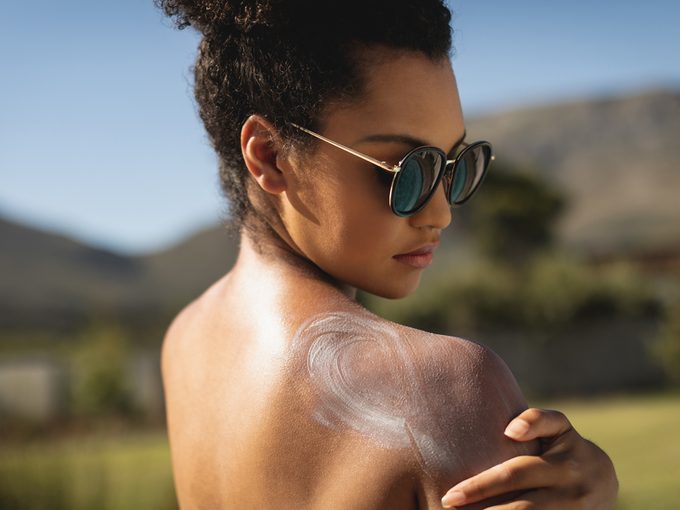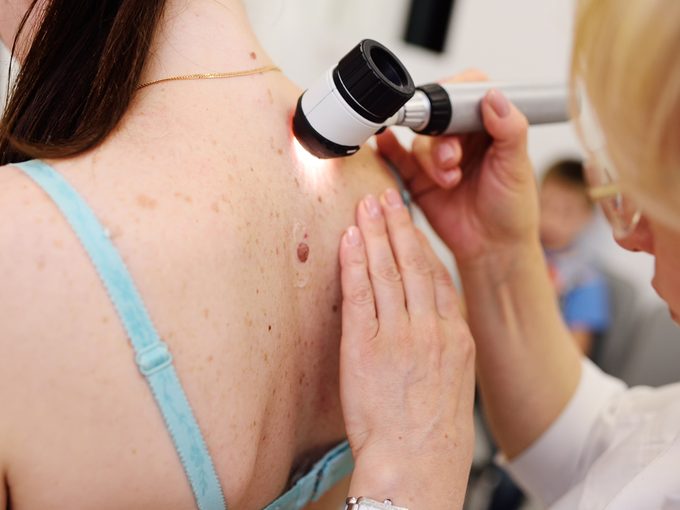This New Online Tool Helps Detect Melanoma Early
Knowing the ABCDEs of melanoma—and watching out for them—may save your life. Neutrogena® has developed a new tool to help.

“While getting dressed one day, my underwear felt a little snugger around my left leg than normal,” remembers Calgary’s Janet Dagenais, a make-up artist and mom of four. “When I reached down to feel where the elastic on my underwear rested in the groin area, I felt a lump the size of a large egg.” Concerned, she went to see her doctor and had an ultrasound and a biopsy. “My doctor called me a week later and told me that I had melanoma.”
For most people, spending unprotected time in the sun—especially as a child—is the primary cause of melanoma. And that’s why Neutrogena® is promoting the importance of daily sunscreen use and has created the Skin Self-Exam Tool to help make sure Canadians of all ages take steps to protect their skin this summer. “According to the World Health Organization, 85 per cent of melanomas among Canadian men and women over 30 years old are attributed to UV radiation exposure,” says Dr. Renita Ahluwalia, lead dermatologist at the Canadian Dermatology Centre. “A single blistering sunburn before age 20 increases the risk of developing melanoma late in life.”
The first step is prevention
“You are responsible for taking care of yourself,” Janet stresses. “There is no excuse for being sunburned. Consider it life or potential death.” And that’s true no matter your age or skin tone. (Even dark skin needs sun protection!)
Here are Dr. Ahluwalia’s top tips for preventing skin cancer:
- Avoid peak hours of the sun (from 11 a.m. to 3 p.m.) when the UV index is the highest.
- Wear a hat to protect your scalp and shade your face. (Janet also sprays her scalp with sunscreen like Neutrogena Ultra Sheer Body Mist.)
- Wear sunscreen like Neutrogena Ultra Sheer Dry-Touch Lotion on your face and body (even on cloudy days) and be sure to apply it liberally to your kids. “Look for a sunscreen that is broad-spectrum, meaning it will protect you from UVB and UVA rays,” says Dr. Ahluwalia. “The proper amount is shot glass amount for the body and a teaspoon amount for the face.” The Canadian Dermatology Association recommends a minimum of SPF 30.
- Find a sunscreen formula that suits you. There are all different types, whether you like a mist, easy-to-tote stick, lightweight water gel or moisturizing face serum. The best format is the one that you’ll actually use.
- Wear sunglasses to protect your eyes.
- Wear sun-protective clothing, ideally with UPF 50.

Why early diagnosis matters
Prevention is just the first step. Step two is watching for abnormalities in your skin. “Melanoma can spread to the lymph nodes and other organs,” says Dr. Ahluwalia. “When caught late, melanoma can be deadly. But when caught early, the prognosis of melanoma and other types of skin cancer is excellent.” In fact, it’s almost 100 per cent.
However, 21 per cent of early-stage melanomas went undiagnosed globally during the pandemic because so many professional skin-check appointments were cancelled due to COVID-19 lockdowns. In Canada, 1,999 melanomas have missed early diagnosis since the start of the pandemic.

Performing self-checks at home
Melanoma is one of the most common types of cancer among Canadians aged 15 to 49, but it can affect anyone, no matter their age, race or sex. That means it’s important for everyone to check their skin for signs of skin cancer. That’s why Neutrogena® launched their Skin Self-Exam tool—so Canadians can educate themselves and learn to perform skin checks at home. It includes steps, helpful information and images of the ABCDEs of melanoma:
- A for asymmetry
- B for border irregularity
- C for multiple colours
- D for large diameter
- E for evolving (meaning the spot or mole has changed)
Add this tool into your monthly routine. If melanoma ends up being part of your story, you’ll have a better chance of catching it early.

When it’s time to see a doctor
There are some instances where you’ll need to do more than just examine your skin at home. In these instances, book an appointment with your family doctor or, ideally, get a referral to a dermatologist:
- If you notice anything unusual during a self-exam
- If you have a family history of melanoma
- If you’ve spent significant time in the sun
- If you have a personal history of melanoma or skin cancer
“As a child I had numerous sunburns that blistered,” says Janet. “I’m fearful now that I will develop melanoma on my back, shoulders or head. I’m grateful that I see a dermatologist often to catch it early if it happens to show up in a new location.”

Your routine can make a difference
By wearing sunscreen every day and performing monthly self-exams, you have a good chance of preventing skin cancer—or catching it early if it pops up. And that’s very, very good news.
Want to learn more about the importance of sun protection and the dangers of melanoma?
Neutrogena® has partnered with Melanoma Canada (MC) to spread awareness about the importance of protecting your skin this summer. Check out the new self-exam tool and visit neutrogena.ca to purchase sunscreens or learn more about the formulas that will work best for you.





